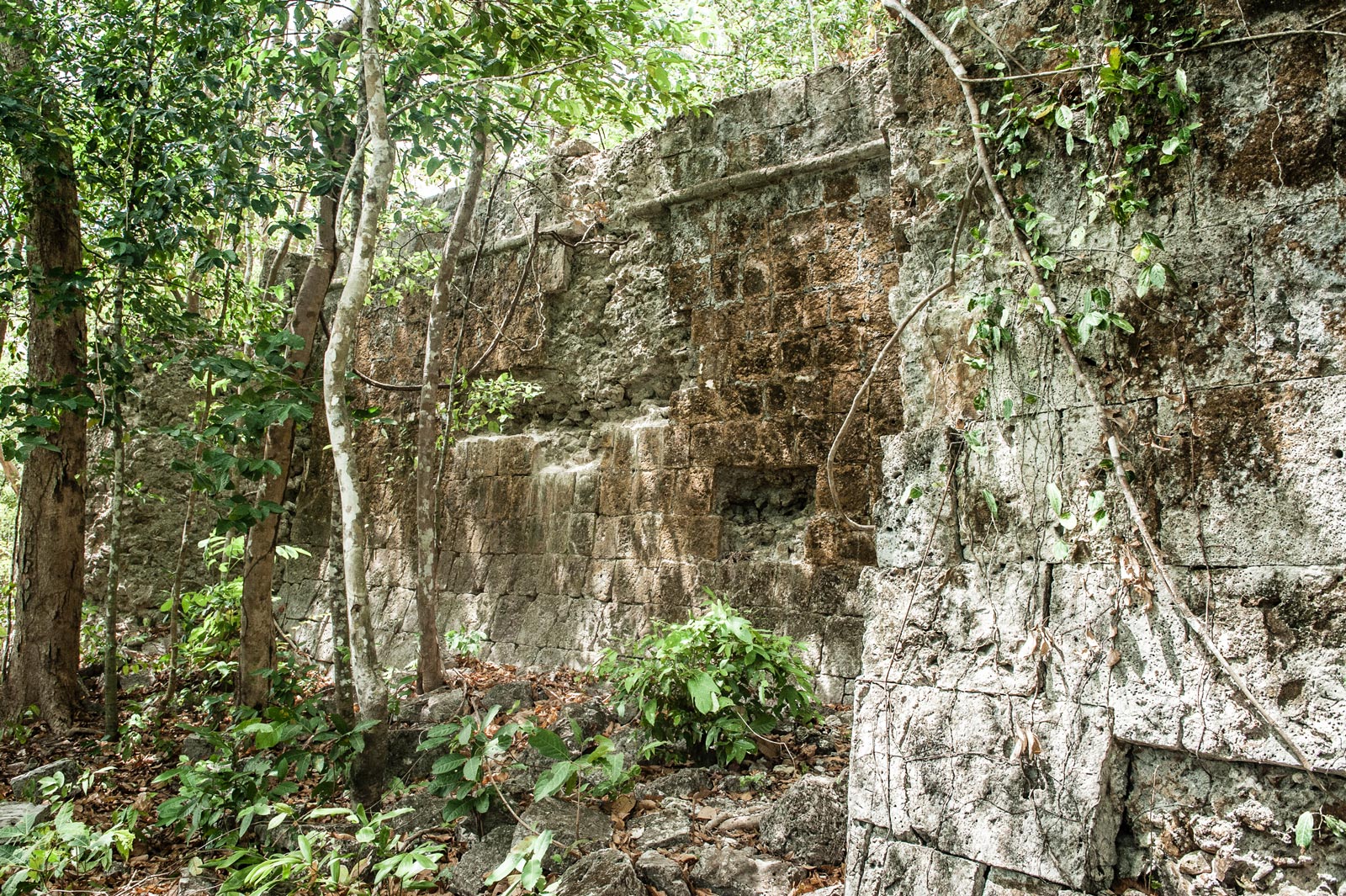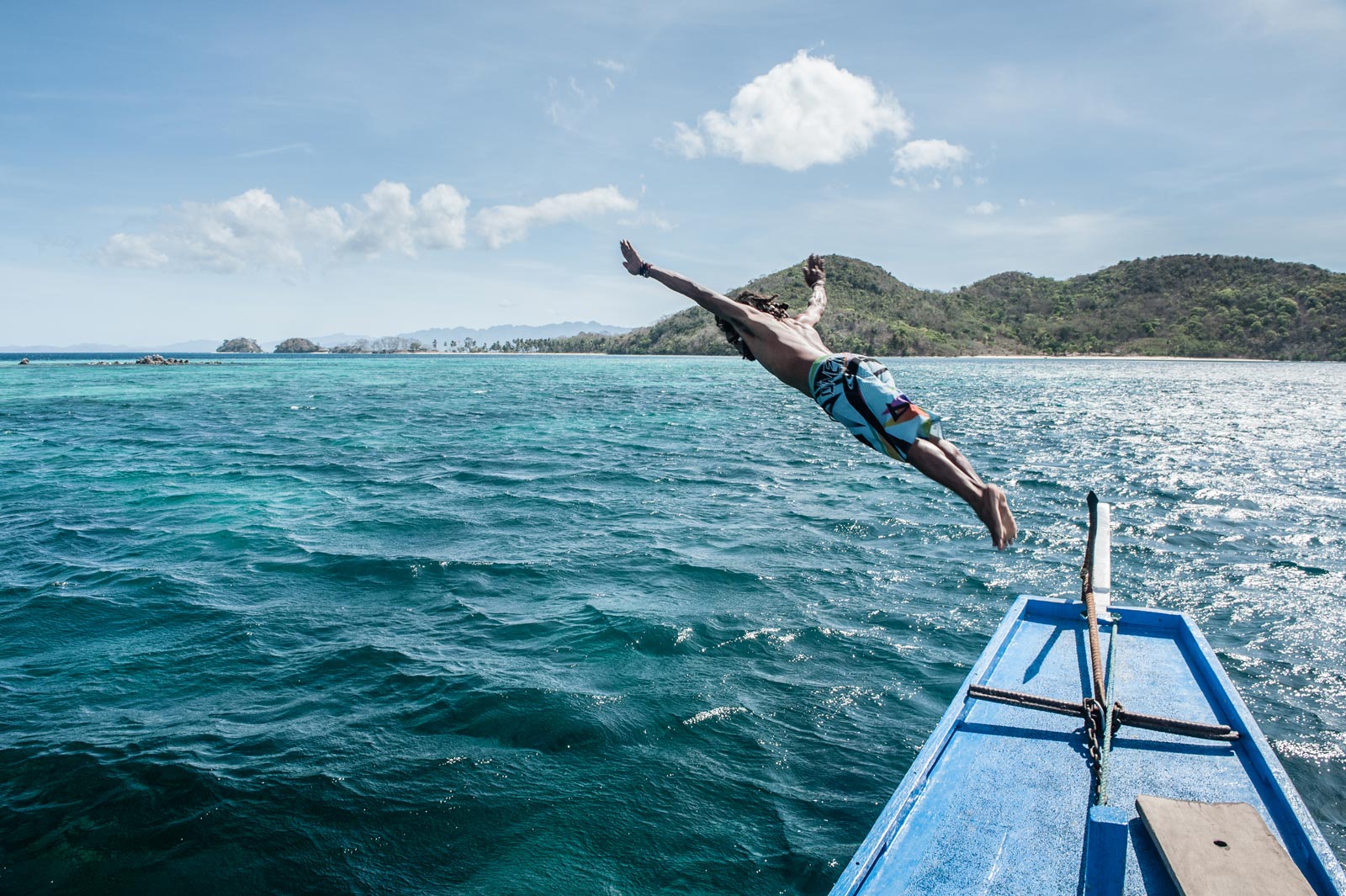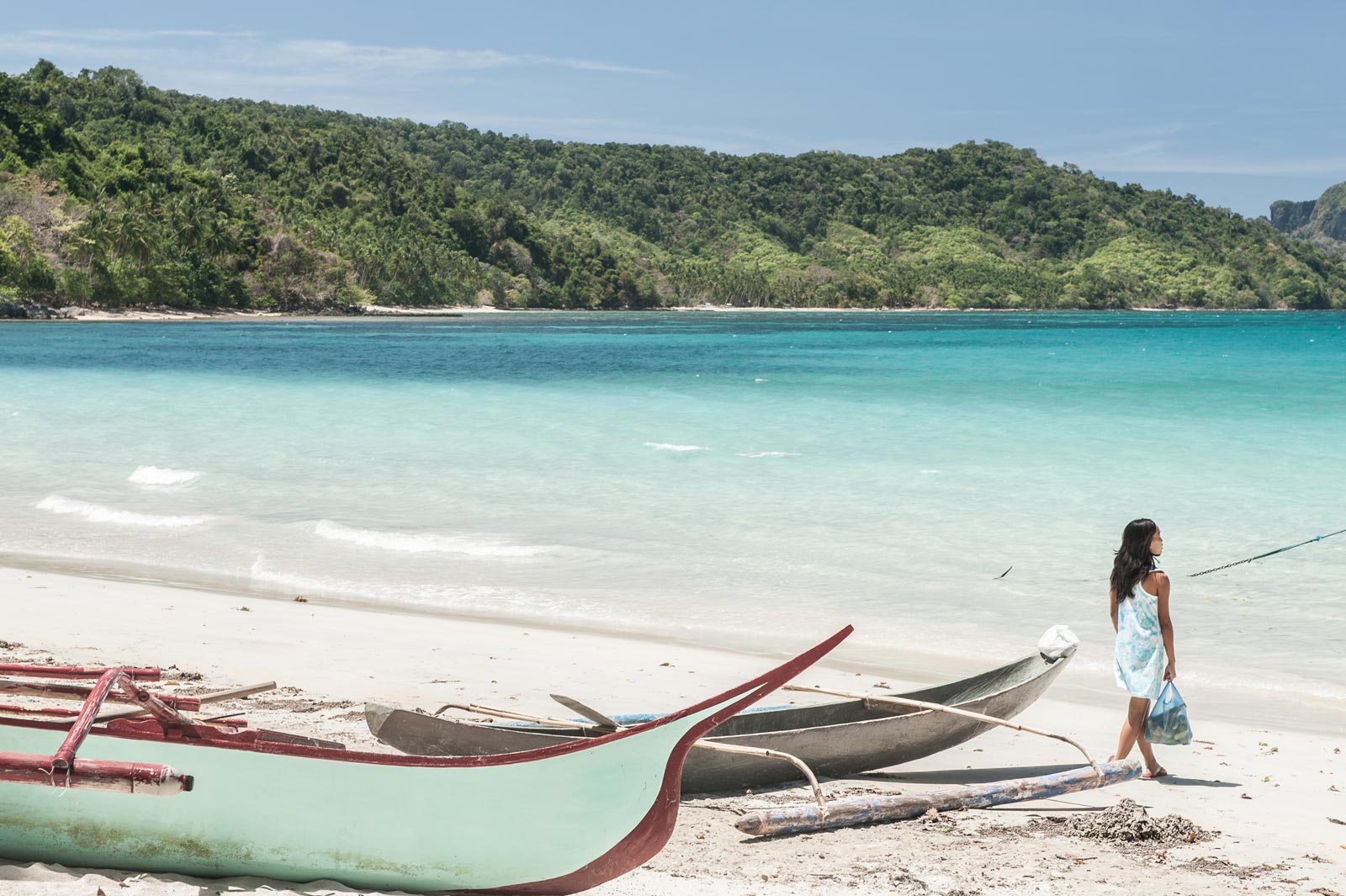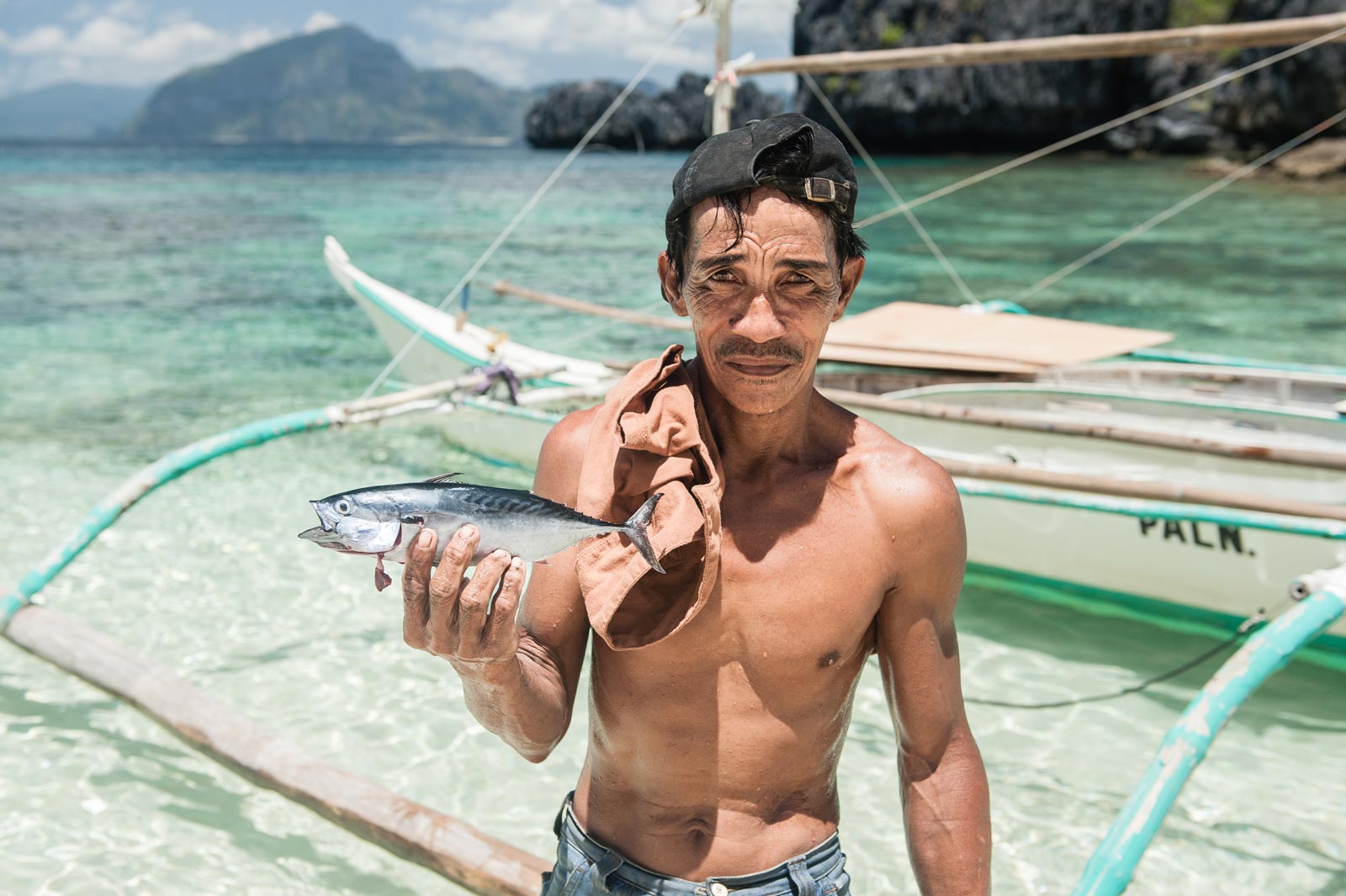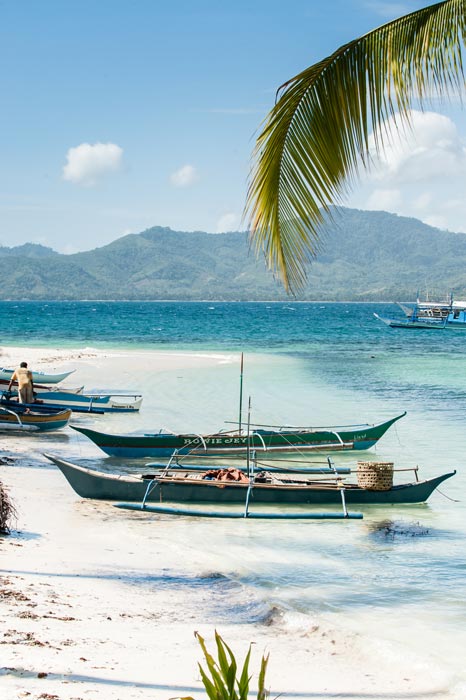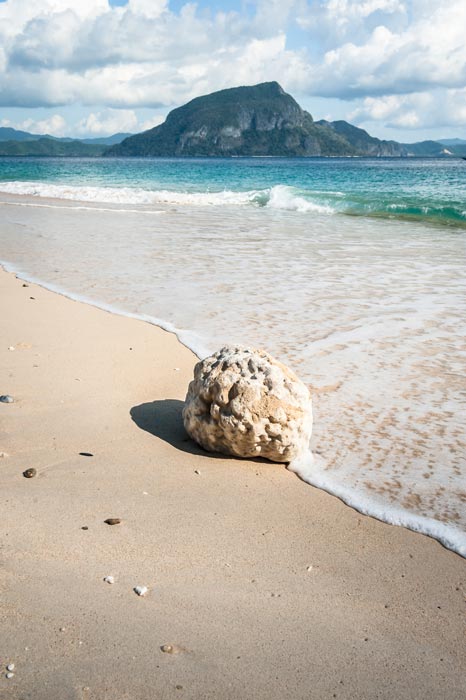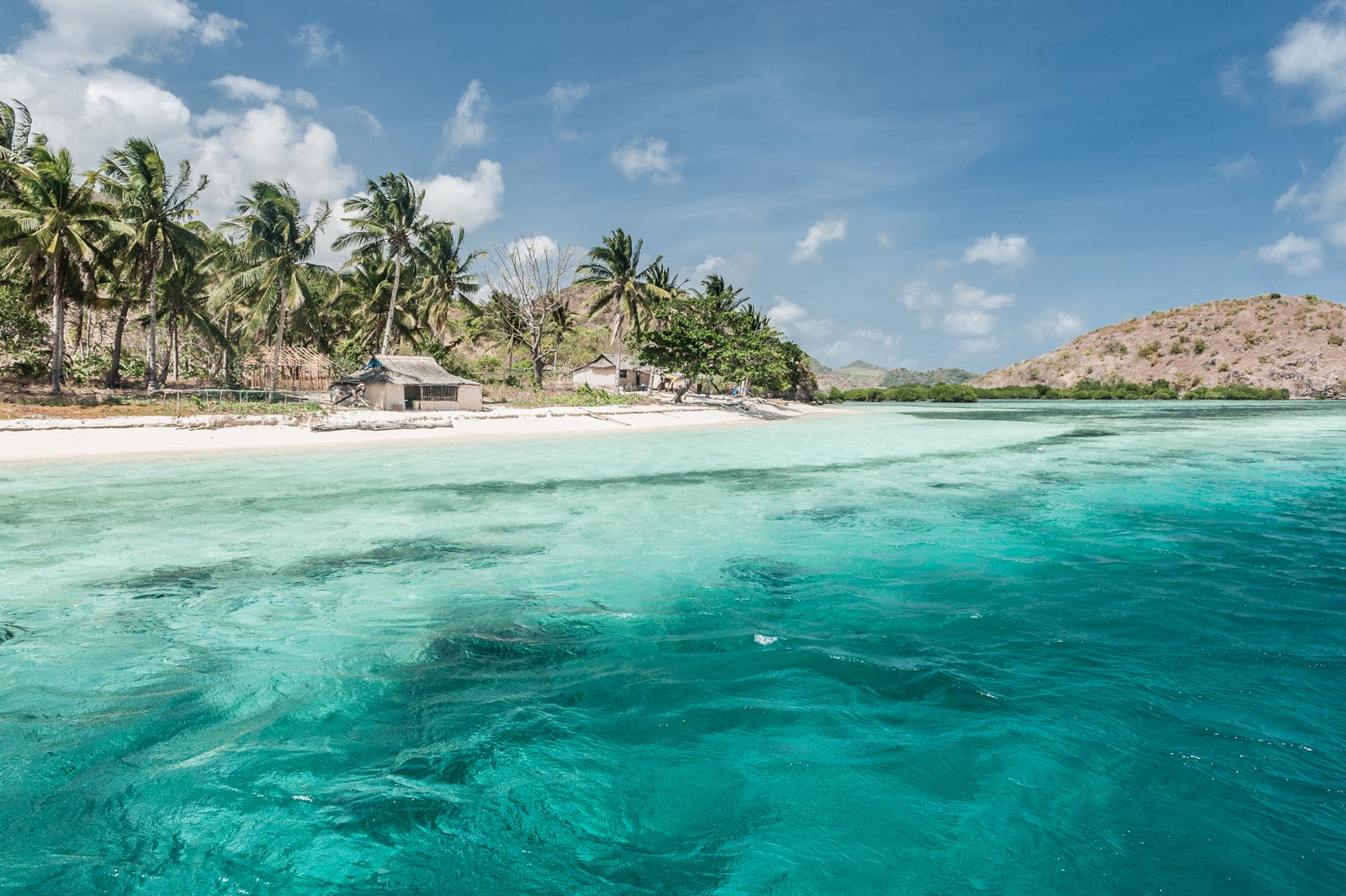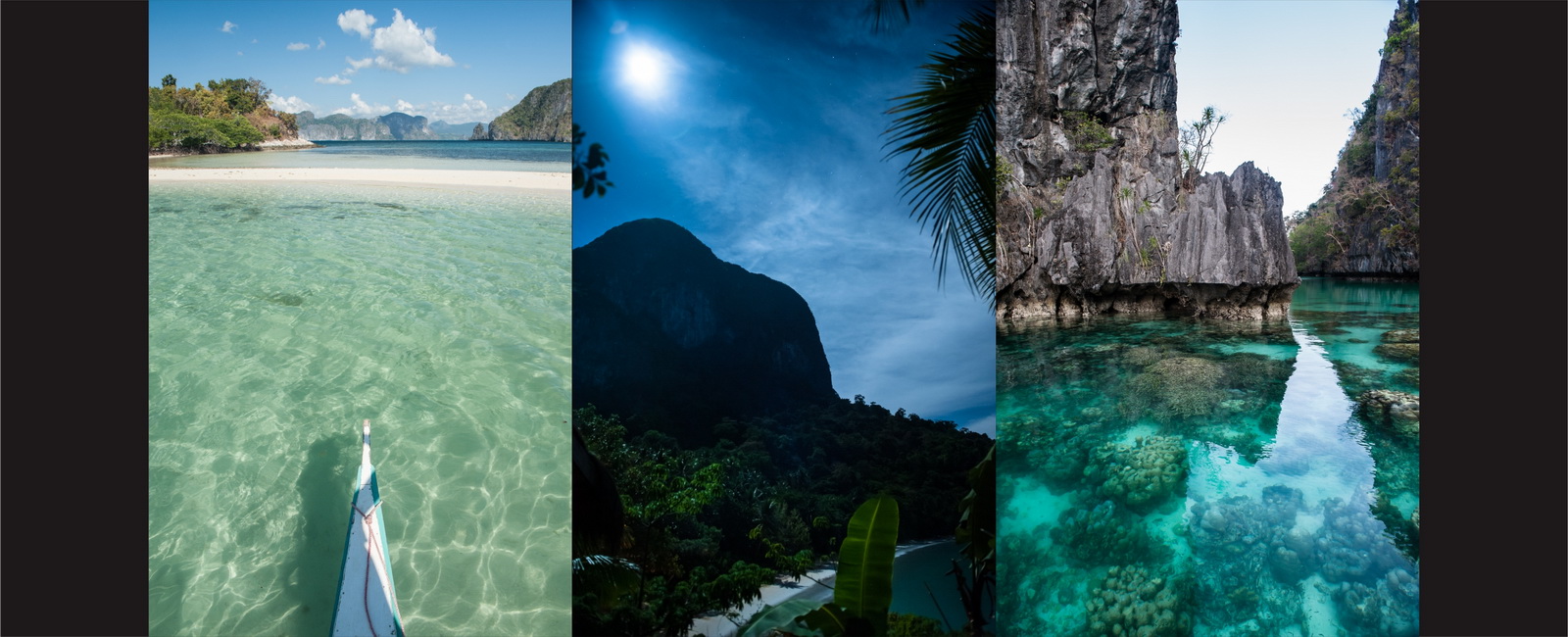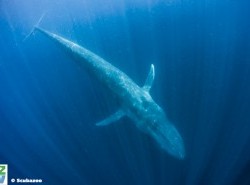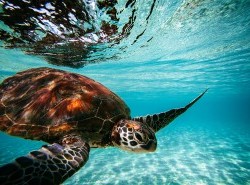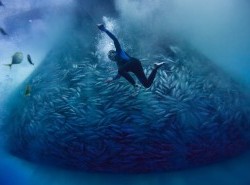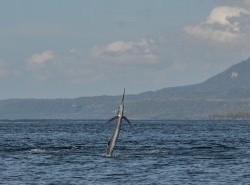We climb a steep hillside through the jungle until we reach a large, stone wall enmeshed in tangled vines and trees roots. Although I have been to northern Palawan many times, I have never before seen the old lost fortress of Linapacan Island. In fact, because of the remoteness of these slips of land – Linapacan is one of over 1,700 islands that make up Palawan, the Philippine’s far western province – few people have seen the fortress. Finally arriving at the fortress, some four days after I departed Palawan’s capital, Puerto Princesa, I feel like I’m the first outsider to fall under its charms.
The interior of the fort, a relic of Palawan’s days as a Spanish stronghold in the 18th century, is grown over with trees and carpeted with fallen leaves. It seems that we are in a forgotten world as we rest in the shade, looking out on a dazzling sea. Out boat, Tao Diwa, awaits us below and we soon set sail again among the myriad islands that are scattered into the distance.
We are travelling with Tao Philippines, an expedition-style travel company founded in 2005 by Filipino Eddie Brock and his British partner Jack Foottit, which is opening up this almost untouched part of the world to visitors. But these trips are not for everyone. “You must be open to genuine adventure,” says Foottit. “We provide the boats, crew, equipment and knowledge of the islands but the other 50 percent comes from you – your interest, enthusiasm and adventurous spirit.”
Brock grew up in the Philippines’ mountainous Cordillera region but left for the UK when he was a teenager. He stayed there for a decade but would regularly return with friends to explore far-flung corners of his native country. Having exhausted almost all known tourist routes, he found he needed his own boat to access more isolated islands. He asked Foottit, who was then a 21-year-old architecture student in Edinburgh, to help design and build a Filipino banca and soon after the two friends mapped out the business model for what would become Tao Philippines.
We are travelling with Tao Philippines, an expedition-style travel company founded in 2005 by Filipino Eddie Brock and his British partner Jack Foottit, which is opening up this almost untouched part of the world to visitors. But these trips are not for everyone. “You must be open to genuine adventure,” says Foottit. “We provide the boats, crew, equipment and knowledge of the islands but the other 50 percent comes from you – your interest, enthusiasm and adventurous spirit.”
Brock grew up in the Philippines’ mountainous Cordillera region but left for the UK when he was a teenager. He stayed there for a decade but would regularly return with friends to explore far-flung corners of his native country. Having exhausted almost all known tourist routes, he found he needed his own boat to access more isolated islands. He asked Foottit, who was then a 21-year-old architecture student in Edinburgh, to help design and build a Filipino banca and soon after the two friends mapped out the business model for what would become Tao Philippines.
The starting point of our journey is the town of El Nido (“the nest” in Spanish), overlooking the surreal limestone islets that dot Bacuit Bay. Towering marble cliffs, hidden lagoons, white beaches and lush rainforest are all attractions, but the area is probably best known for its edible birds’ nests, gathered by locals from caves in rugged mountain outcrops. We stay at Talikwas House, a lodging and yoga retreat perched high above the ocean, away from the jumble of backpacker lodgings in town.
By chance our visit coincides with the annual El Nido arts festival and we catch a concert by Lolita Carbon of the legendary Filipino folk-rock band Asin. Her music, much of which draws inspiration from indigenous and environmental issues, is apt in this landscape of ancient karst formations, home to some of the oldest conservation laws in the Philippines. In as early as 1935 the first small forest reserve was declared in El Nido and by 1991, a 95,000-hectare marine reserve had been established to protect the area’s colourful coral reefs and aquatic life, including dugongs, whale sharks and three species of sea turtles.
Our journey aboard the Tao Diwa begins early the next morning. With such a natural wealth of islands, beaches and reefs to explore throughout the Bacuit Archipelago, as well as across the Linapacan Strait and north into the Calamianes, we do not plan a set route or itinerary. “We have the basics – food, water and essentials for the sea and sleeping on the islands – but the real essence of our expedition is simplicity in its natural, organic form,” says Brock. “We leave after breakfast on the first day, and arrive before nightfall on the last. What happens in between is up to you.”
Without a schedule to adhere to, we decide to stop just an hour after pushing off. Cadlao Island, a protrusion of forest-clad mountains fringed by powdery beaches, also happens to be home to Tao’s rustic headquarters. We laze in hammocks, swim and meet Amit Elan, a 21-year-old Israeli artist, painting in his temporary jungle studio. We feast on a lunch of fresh Spanish mackerel, mud crabs and squash in coconut milk, the first of many delicious picnics prepared by our on-board chef.
In the afternoon we set sail again, bound for our overnight destination – a speck of an island called Daracouton, off the northernmost tip of mainland Palawan. Along the way we glimpse lone fishermen in small paddleboats bobbing on the waves, their faces deeply tanned from many hours spent at sea. Our crew, who are all Palawan natives, know some of the fishermen and buy from one a freshly caught snapper.
Though the weather is fine, a strong wind slows our progress, so it’s dark by the time we approach Daracouton. The horizon is lit by boats harvesting squid, a crescent moon is up and Tao Diwa is trailing a stream of sparkling bioluminescence. On shore, villagers are waiting with lanterns to guide us up the beach to a simple cabana that has been prepared with crisp white bed linens and mosquito nets. After bathing outside in a large basin next to the communal water pump, we sit down to dinner – our snapper, grilled over hot coals – under an inky sky speckled with stars.
I’m woken the next morning by a chorus of cicadas and the smell of freshly brewed Benguet coffee. We decide to explore the island on foot in the cool of the morning and set off down a gently curving beach broken by a muddle of fishing boats and huge boulders over which we scramble. Our companions are a couple of friendly island dogs chasing monitor lizards through the shrubbery. As we walk, Brock talks about his childhood. “I grew up in a very traditional Igorot family, the proudest culture in the Philippines,” he says. “This gave me a sense of the importance of the island cultures when I came to Palawan.
The sun is high by the time we return to the village. Men and women are sorting through their seaweed harvest while children play on the beach. Watching this idyllic scene, it’s easy to appreciate the simple beauty of rural Filipino life. But there is a flipside: the people here have low incomes and scant access to education and healthcare. Brock is mindful that to keep Tao’s visits sustainable the company must give back something meaningful to the community. “Tourism should work both ways – benefiting the traveller and the host alike,” he says. His company employs 250 local staff and buys almost all of its expedition supplies – food, drinks and boat equipment – from the islanders. Included in the price of each expedition is a donation to social welfare projects that largely focus on children, providing day-care centres, teachers, school supplies and supplementary food.
We leave Daracouton and continue our journey across the Linapacan Strait and into the Calamianes. It is extremely difficult to access these islands unless you have your own boat and the only outsiders that we see are a handful of foreigners travelling on a small ferry from El Nido to Coron. Although we are essentially on the same route – our expedition will end in the same port – the direct trip will take them around seven hours, while our meandering journey lasts for five blissful days.
We stop whenever we feel the urge to explore an empty beach or snorkel over a colourful coral reef. Palawan lies within the Coral Triangle – an area demarcated by scientists across Indonesia, the Philippines, Malaysia and other Pacific countries as being home to the highest marine biodiversity on the planet – and the waters around El Nido alone are home to nearly 200 fish species. Underwater, we encounter channels with vibrant reefs fed by strong currents, giant clams with glistening mantles and corals covered in multi-coloured Christmas tree worms that hide and reappear as we pass. We see boldly patterned lionfish and, on the beaches, find strange rock formations, puzzle fruits and turtle footprints.
Our final stop, Coron Island, is a huge limestone outcrop home to indigenous Tagbanua people. The isle is off-limits to visitors save for two sacred lakes –Kayangan and Barracuda. Kayangan is renowned as the cleanest lake in the country and the caves on its steep cliffs are home to edible-nest swiftlets. Nearby is Barracuda Lake, known by divers for its shimmering thermoclines, caused by geothermal activity beneath the island, which separate cooler levels on the surface from 37°C water below.
It’s easy to fall into rhythm with this life of spontaneity on the water – over the hours that we drift between islands and reefs, I can’t help but disconnect from the modern world. Days of jungle walks, village living, exploring ruins and swimming eventually roll into each other and come to an end, all too soon. Upon arriving in Coron town, I find myself reluctant to leave the sun-kissed deck of the Tao Diwa behind, the only comfort being that I know I will be back here – and staying for longer – before too long.
By chance our visit coincides with the annual El Nido arts festival and we catch a concert by Lolita Carbon of the legendary Filipino folk-rock band Asin. Her music, much of which draws inspiration from indigenous and environmental issues, is apt in this landscape of ancient karst formations, home to some of the oldest conservation laws in the Philippines. In as early as 1935 the first small forest reserve was declared in El Nido and by 1991, a 95,000-hectare marine reserve had been established to protect the area’s colourful coral reefs and aquatic life, including dugongs, whale sharks and three species of sea turtles.
Our journey aboard the Tao Diwa begins early the next morning. With such a natural wealth of islands, beaches and reefs to explore throughout the Bacuit Archipelago, as well as across the Linapacan Strait and north into the Calamianes, we do not plan a set route or itinerary. “We have the basics – food, water and essentials for the sea and sleeping on the islands – but the real essence of our expedition is simplicity in its natural, organic form,” says Brock. “We leave after breakfast on the first day, and arrive before nightfall on the last. What happens in between is up to you.”
Without a schedule to adhere to, we decide to stop just an hour after pushing off. Cadlao Island, a protrusion of forest-clad mountains fringed by powdery beaches, also happens to be home to Tao’s rustic headquarters. We laze in hammocks, swim and meet Amit Elan, a 21-year-old Israeli artist, painting in his temporary jungle studio. We feast on a lunch of fresh Spanish mackerel, mud crabs and squash in coconut milk, the first of many delicious picnics prepared by our on-board chef.
In the afternoon we set sail again, bound for our overnight destination – a speck of an island called Daracouton, off the northernmost tip of mainland Palawan. Along the way we glimpse lone fishermen in small paddleboats bobbing on the waves, their faces deeply tanned from many hours spent at sea. Our crew, who are all Palawan natives, know some of the fishermen and buy from one a freshly caught snapper.
Though the weather is fine, a strong wind slows our progress, so it’s dark by the time we approach Daracouton. The horizon is lit by boats harvesting squid, a crescent moon is up and Tao Diwa is trailing a stream of sparkling bioluminescence. On shore, villagers are waiting with lanterns to guide us up the beach to a simple cabana that has been prepared with crisp white bed linens and mosquito nets. After bathing outside in a large basin next to the communal water pump, we sit down to dinner – our snapper, grilled over hot coals – under an inky sky speckled with stars.
I’m woken the next morning by a chorus of cicadas and the smell of freshly brewed Benguet coffee. We decide to explore the island on foot in the cool of the morning and set off down a gently curving beach broken by a muddle of fishing boats and huge boulders over which we scramble. Our companions are a couple of friendly island dogs chasing monitor lizards through the shrubbery. As we walk, Brock talks about his childhood. “I grew up in a very traditional Igorot family, the proudest culture in the Philippines,” he says. “This gave me a sense of the importance of the island cultures when I came to Palawan.
The sun is high by the time we return to the village. Men and women are sorting through their seaweed harvest while children play on the beach. Watching this idyllic scene, it’s easy to appreciate the simple beauty of rural Filipino life. But there is a flipside: the people here have low incomes and scant access to education and healthcare. Brock is mindful that to keep Tao’s visits sustainable the company must give back something meaningful to the community. “Tourism should work both ways – benefiting the traveller and the host alike,” he says. His company employs 250 local staff and buys almost all of its expedition supplies – food, drinks and boat equipment – from the islanders. Included in the price of each expedition is a donation to social welfare projects that largely focus on children, providing day-care centres, teachers, school supplies and supplementary food.
We leave Daracouton and continue our journey across the Linapacan Strait and into the Calamianes. It is extremely difficult to access these islands unless you have your own boat and the only outsiders that we see are a handful of foreigners travelling on a small ferry from El Nido to Coron. Although we are essentially on the same route – our expedition will end in the same port – the direct trip will take them around seven hours, while our meandering journey lasts for five blissful days.
We stop whenever we feel the urge to explore an empty beach or snorkel over a colourful coral reef. Palawan lies within the Coral Triangle – an area demarcated by scientists across Indonesia, the Philippines, Malaysia and other Pacific countries as being home to the highest marine biodiversity on the planet – and the waters around El Nido alone are home to nearly 200 fish species. Underwater, we encounter channels with vibrant reefs fed by strong currents, giant clams with glistening mantles and corals covered in multi-coloured Christmas tree worms that hide and reappear as we pass. We see boldly patterned lionfish and, on the beaches, find strange rock formations, puzzle fruits and turtle footprints.
Our final stop, Coron Island, is a huge limestone outcrop home to indigenous Tagbanua people. The isle is off-limits to visitors save for two sacred lakes –Kayangan and Barracuda. Kayangan is renowned as the cleanest lake in the country and the caves on its steep cliffs are home to edible-nest swiftlets. Nearby is Barracuda Lake, known by divers for its shimmering thermoclines, caused by geothermal activity beneath the island, which separate cooler levels on the surface from 37°C water below.
It’s easy to fall into rhythm with this life of spontaneity on the water – over the hours that we drift between islands and reefs, I can’t help but disconnect from the modern world. Days of jungle walks, village living, exploring ruins and swimming eventually roll into each other and come to an end, all too soon. Upon arriving in Coron town, I find myself reluctant to leave the sun-kissed deck of the Tao Diwa behind, the only comfort being that I know I will be back here – and staying for longer – before too long.
